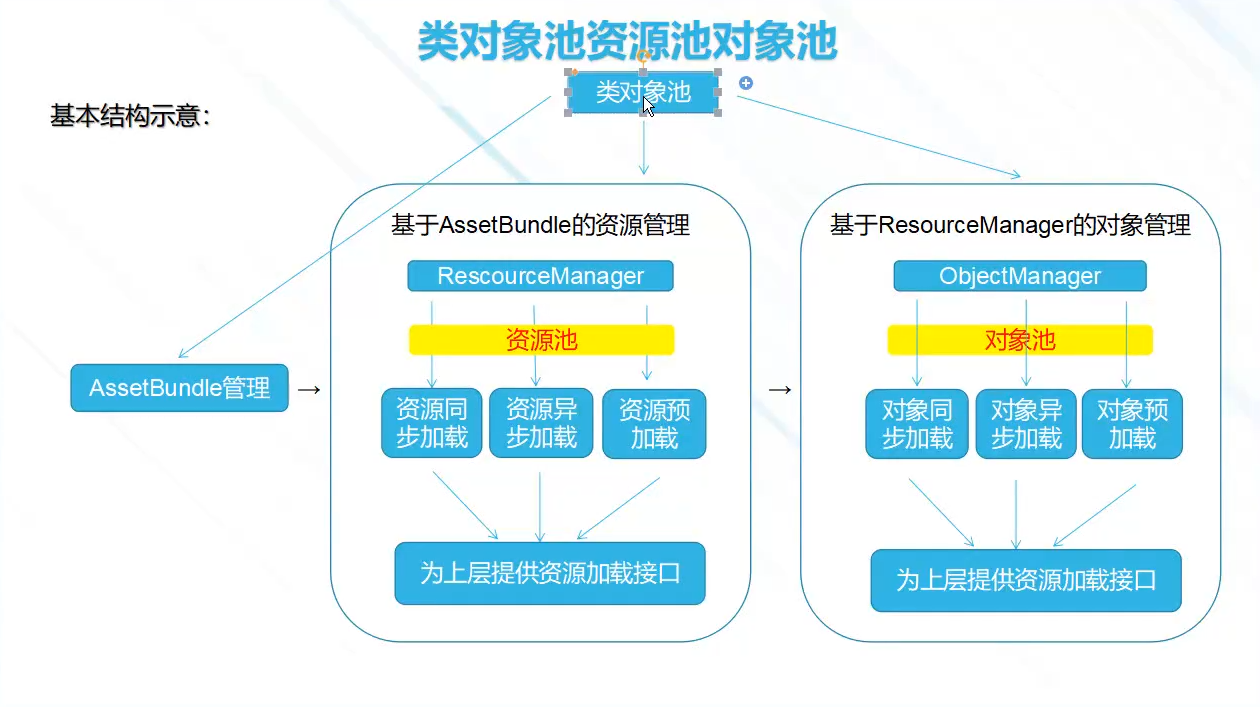对象池基本介绍

类对象池
提前缓存一些基础类的对象,在其他管理类使用时直接从类对象池中取出。
类对象池需要自行实现还原的方法,因为每个具体的类不一样,所以每个类的变量修改后返回到对象池时需要自行重置
在下面的AssetBundle Manager中,AssetBundleItem这个由对象池管理的类就自己实现了一个Reset方法
需要重置的原因是我们的对象池使用Stack<T>,每一次Pop出来的对象都必须的是一样的
AssetBundle管理
读取配置表和依赖加载的管理
资源池管理
资源池管理(ResouceManager)是Asset Bundle管理的上层。
其中异步加载通过使用协程和循环来控制每一帧资源加载的容量来流畅加载。
资源池重点处理的是资源,图片、声音、视频、文字等,还包括未实例化的Prefab。
资源池为上层提供资源加载的接口。
对象池管理
对象池管理(ObjectManager)是资源池管理的上层。
针对需要实例化的对象进行缓存,根据对象是否常用来决定是否放进对象池中。其中异步加载需要实现取消加载,对象池中的对象可能在加载中途不需要加载了。
类对象池
新建ClassObjectPool脚本
1
2
3
4
5
6
7
8
9
10
11
12
13
14
15
16
17
18
19
20
21
22
23
24
25
26
27
28
29
30
31
32
33
34
35
36
37
38
39
40
41
42
43
44
45
46
47
48
49
50
51
52
53
54
55
| using System.Collections.Generic;
public class ClassObjectPool<T> where T : class, new()
{
protected Stack<T> m_Pool = new Stack<T>();
protected int m_MaxCount = 0;
protected int m_NoRecycleCount = 0;
public ClassObjectPool(int maxCount)
{
m_MaxCount=maxCount;
for (int i = 0; i < maxCount; i++)
{
m_Pool.Push(new T());
}
}
public T Spawn(bool createIfEmpty)
{
if (m_Pool.Count > 0)
{
T rtn = m_Pool.Pop();
if (rtn == null)
{
if(createIfEmpty)
{
rtn = new T();
}
}
m_NoRecycleCount++;
return rtn;
}
else
{
if (createIfEmpty)
{
T rtn = new T();
m_NoRecycleCount++;
return rtn;
}
}
return null;
}
public bool Recycle(T obj)
{
if(obj == null) { return false; }
m_NoRecycleCount--;
if(m_Pool.Count >= m_MaxCount && m_MaxCount>0)
{
obj = null;
return false;
}
m_Pool.Push(obj);
return true;
}
}
|
ObjectPoolManager
单例模板
1
2
3
4
5
| public class SingletonPattern<T> where T : new()
{
public static T Instance => _instance ??= new T();
private static T _instance;
}
|
1
2
3
4
5
6
7
8
9
10
11
12
13
14
15
16
17
18
19
20
21
22
23
24
25
| using System;
using System.Collections.Generic;
public class ObjectPoolManager:SingletonPattern<ObjectPoolManager>
{
#region 类对象池的使用
protected Dictionary<Type, object> m_ClassPoolDic = new Dictionary<Type, object>();
public ClassObjectPool<T> GetOrCreatClassPool<T>(int maxCount) where T : class, new()
{
Type type = typeof(T);
object outObj = null;
if (!m_ClassPoolDic.TryGetValue(type, out outObj) || outObj == null)
{
ClassObjectPool<T> newPool = new ClassObjectPool<T>(maxCount);
m_ClassPoolDic.Add(type, newPool);
return newPool;
}
return outObj as ClassObjectPool<T>;
}
#endregion
}
|
AssetBundleManager
- 读取Asset Bundle配置表
- 设置中间类进行引用计数
- 根据路径加载Asset Bundle
- 根据路径卸载Asset Bundle
- 为Resource Manager提供加载中间类,根据中间类释放资源,查找中间类等方法。
1
2
3
4
5
6
7
8
9
10
11
12
13
14
15
16
17
18
19
20
21
22
23
24
25
26
27
28
29
30
31
32
33
34
35
36
37
38
39
40
41
42
43
44
45
46
47
48
49
50
51
52
53
54
55
56
57
58
59
60
61
62
63
64
65
66
67
68
69
70
71
72
73
74
75
76
77
78
79
80
81
82
83
84
85
86
87
88
89
90
91
92
93
94
95
96
97
98
99
100
101
102
103
104
105
106
107
108
109
110
111
112
113
114
115
116
117
118
119
120
121
122
123
124
125
126
127
128
129
130
131
132
133
134
135
136
137
138
139
140
141
142
143
144
145
146
147
148
149
150
151
152
153
154
155
156
157
158
159
160
161
162
163
164
165
166
167
168
169
170
171
172
173
174
175
176
177
178
179
180
181
182
183
184
185
186
187
188
189
190
191
192
193
194
195
196
197
198
199
200
201
202
203
204
205
206
207
208
| using System.Collections.Generic;
using System.IO;
using System.Runtime.Serialization.Formatters.Binary;
using UnityEngine;
public class AssetBundleManager : SingletonPattern<AssetBundleManager>
{
protected Dictionary<uint,ResourceItem> m_ResourceItemDic = new Dictionary<uint,ResourceItem>();
protected Dictionary<uint,AssetBundleItem> m_AssetBundleItemDic = new Dictionary<uint,AssetBundleItem>();
protected ClassObjectPool<AssetBundleItem> m_AssetBundleItemPool = ObjectPoolManager.Instance.GetOrCreatClassPool<AssetBundleItem>(500);
public bool LoadAssetBundleConfig()
{
m_ResourceItemDic.Clear();
string configPath = Application.streamingAssetsPath + "/assetbundleconfig";
AssetBundle configAB = AssetBundle.LoadFromFile(configPath);
TextAsset textAsset = configAB.LoadAsset<TextAsset>("AssetBundleConfig");
if (textAsset == null )
{
Debug.LogError("AssetBundleConfig isn't exist");
return false;
}
using (MemoryStream ms = new MemoryStream(textAsset.bytes))
{
BinaryFormatter bf = new BinaryFormatter();
AssetBundleConfig abConfig = (AssetBundleConfig)bf.Deserialize(ms);
for (int i = 0; i < abConfig.ABBasesList.Count; i++)
{
ABBase abBase = abConfig.ABBasesList[i];
ResourceItem resItem = new ResourceItem
{
m_Crc = abBase.Crc,
m_AssetName = abBase.AssetName,
m_AssetBundleName = abBase.ABName,
m_DependAssetBundle = abBase.ABDependence,
};
if(m_ResourceItemDic.ContainsKey(resItem.m_Crc))
{
Debug.LogError("重复的Crc 资源名:" + resItem.m_AssetName + "AB包名:" + resItem.m_AssetBundleName);
}
else
{
m_ResourceItemDic.Add(resItem.m_Crc, resItem);
}
}
return true;
}
}
public ResourceItem LoadResourceAssetBundle(uint crc)
{
ResourceItem resItem = null;
if(!m_ResourceItemDic.TryGetValue(crc, out resItem) || resItem == null)
{
Debug.LogErrorFormat("LoadResourceAssetBundle error: can not find crc {0} in AssetBundleConfig",crc.ToString());
return resItem;
}
resItem.m_AssetBundle = LoadAssetBundle(resItem.m_AssetBundleName);
if(resItem.m_DependAssetBundle != null)
{
resItem.m_DependAssetBundle.ForEach(abName =>
{
LoadAssetBundle(abName);
});
}
return resItem;
}
private AssetBundle LoadAssetBundle(string abName)
{
AssetBundleItem abItem = null;
uint abCrc = CRC32.GetCRC32(abName);
if(!m_AssetBundleItemDic.TryGetValue(abCrc, out abItem))
{
AssetBundle assetBundle = null;
string fullPath = Application.streamingAssetsPath + "/" + abName;
#if UNITY_ANDROID
assetBundle = AssetBundle.LoadFromFile(fullPath);
#else
if(File.Exists(fullPath))
{
assetBundle = AssetBundle.LoadFromFile(fullPath);
}
#endif
if (assetBundle == null)
{
Debug.LogError("Load AssetBundle Error:" + fullPath);
}
abItem = m_AssetBundleItemPool.Spawn(true);
abItem.assetBundle = assetBundle;
abItem.refCount++;
m_AssetBundleItemDic.Add(abCrc, abItem);
}
else
{
abItem.refCount++;
}
return abItem.assetBundle;
}
public void ReleaseAsset(ResourceItem item)
{
if (item == null)
return;
if (item.m_DependAssetBundle != null && item.m_DependAssetBundle.Count > 0)
{
for (int i = 0; i < item.m_DependAssetBundle.Count; i++)
{
UnloadAssetBundle(item.m_DependAssetBundle[i]);
}
}
UnloadAssetBundle(item.m_AssetBundleName);
}
private void UnloadAssetBundle(string abName)
{
uint abCrc = CRC32.GetCRC32(abName);
AssetBundleItem abItem = null;
if(m_AssetBundleItemDic.TryGetValue(abCrc,out abItem) && abItem != null)
{
abItem.refCount--;
if(abItem.refCount <= 0 && abItem.assetBundle != null)
{
abItem.assetBundle.Unload(true);
abItem.Reset();
m_AssetBundleItemPool.Recycle(abItem);
m_AssetBundleItemDic.Remove(abCrc);
}
}
}
public ResourceItem FindResourceItem(uint crc)
{
ResourceItem item = null;
m_ResourceItemDic.TryGetValue(crc, out item);
return item;
}
}
public class AssetBundleItem
{
public AssetBundle assetBundle = null;
public int refCount;
public void Reset()
{
assetBundle=null;
refCount = 0;
}
}
public class ResourceItem
{
public uint m_Crc = 0;
public string m_AssetName = string.Empty;
public string m_AssetBundleName = string.Empty;
public List<string> m_DependAssetBundle = null;
public AssetBundle m_AssetBundle = null;
public Object m_Obj = null;
public int m_GUID = 0;
public float m_LastUseTime = 0.0f;
protected int m_RefCount = 0;
public int RefCount
{
get { return m_RefCount; }
set
{
m_RefCount = value;
if (m_RefCount < 0)
{
Debug.LogError("refcount < 0" + m_RefCount + " ," + (m_Obj != null ? m_Obj.name : "name is null"));
}
}
}
}
|



